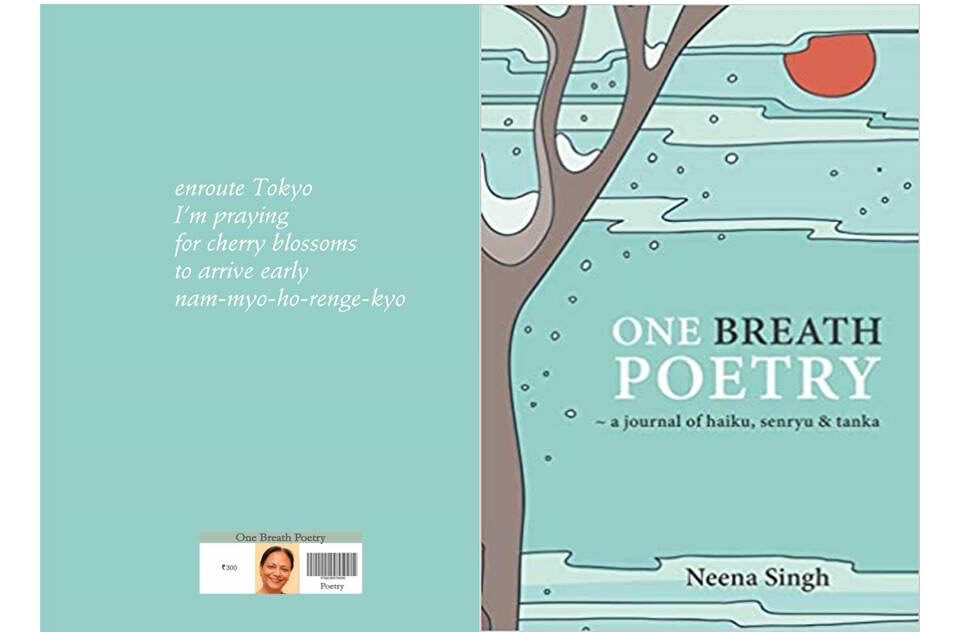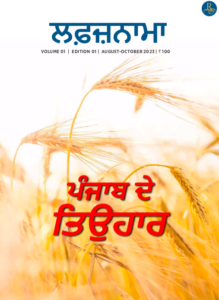Book Review : One Breath Poetry By Neena Singh

One Breath Poetry:
Journal of Haiku, Senryu & Tanka
By Neena Singh, Sambhavna Prakashan, 2020, 168 pages (Hardcover); ISBN: 978-93-81619-12-4 Price: Rs.300
Neena Singh’s maiden collection of Japanese short forms of poetry, ‘One Breath Poetry” is embedded with poems of varied styles that reward reading. Brief head-notes on haiku, senryu, tanka, and on five seasons with elegant black-and-white monochromatic photographs add beauty to the book. She is influenced by the architect of modern Indian haikuist, Angelee Deodhar and the teaching of the Japanese Buddhist priest, Nicghiren of the Kamakura period. The collection reminds me of the seasonal scenes of Gerald Vizenor’s haiku collection, ‘Favor of Crows”.
She chooses to quote the lines from the Persian poet to reflex true to the title of her book:
The sum total of our life is a
breath spent in the company of the Beloved
-Abu Sa’id Abul-Khayr
Neena decodes the images into the art of words as experienced at different places: Japan, Mauritius, Bhutan, Seattle, Florida to Pennsylvania of America, and the Fragrance Garden of Chandigarh. It reminds me of Basho’s view: the haiku is what is happening at the time in this place.
Her poems often set sights on cats, dogs, frogs, butterflies, bees, bats, squirrels, spiders, seashells, cicadas, pigeons, kingfishers, koels, peacocks, and flora like phlox, tecoma, laburnum, bougainvillea, hydrangeas etc.
She experiences the stages of life through the change of seasons: savor in spring, abundance in summer, revival in rain, a fall or loss in autumn, and finally a sense of solitude in winter.
Spring brings exhilaration as she observes:
so many flowers
in the spring breeze
a butterfly flutters (p. 18)
When Issa says: “there is no stranger under the cherry tree.”, Neena shares ecstasy by visiting early flowering cherry trees and discovers the strangers smile:
under the tree
early cherry blossoms–
strangers smile (p. 21)
She blends cultural layers with subtle allusiveness as the moon reveals its sublime presence amongst thick foliage like the leprechaun. The reference of leprechauns in Irish folklore is associated with the fairy in the form of an old man — smoking a pipe, dressed in a leather apron and a hat, and having buckled shoes— who is trailed from the tapping sound of his cobbler hammer.
the full moon
hides in the garden all night:
is it a leprechaun (p. 37)
She uses literary devices (Epizeuxis, Diacope) of repetition of words to create rhythm and emphasis. Her haiku at places are alliterative in nature as she unfolds the abundance of the summer and senses the sound in the stillness of noon:
sun and sand
burnish skin to gold
an unending summer (p.66)
noon stillness
broken: feisty crows scratch
the wooden bench (p. 57)
The fading away of ducks after sunset, “Green lake Park /ducks paddle and fade/ into the sunset” (p. 65), is a captivating visual snapshot by the poet. Interestingly the impression resembles that of Basho’s magical creation:
The sea darkens/ and a wild duck’s call/ is faintly white
Her poetic reflections corroborate with the life-related aspects. The reference of ‘revival’ during the rainy season is aptly captured in one of her haiku:
after the downpour
garden choir – in crescendo
frogs and cicadas (p. 74)
She is a believer in complementary nature (yin-yang). Metaphorically, through the shades of autumn, she explores the sanity of life. It is beautifully crafted in the form of fallen leaves with philosophical allusion.
back to earth
by a gardener’s broom–
dry leaves crackle (p. 90)
She recounts her family association and embraces solitude. Her literal allusion tracks the path to a solemnized end. She says in her introductory note on haiku: “It expresses the wonder of Nature and the seasonal changes, a love for life, and at times, deep thoughts…..composing haiku is a path- a way of observing life and catching the ephemeral with brevity … ”
leafless trees
draw on the skyline
a charcoal sketch (p. 110)
bony arms
hold the sky
life’s winter (p. 122)
mother’s story
remains half-told
half-moon night (p. 137)
Reconciling the reality, she wishes to stay calm and often finds solace through humour:
a piece of my heart
in grandson’s laugh
—aping T-rex (p.132)
barefoot again –
the dog asleep
on my slippers (p.141)
Faith, love, emotion, and philosophical penchant have been reflected in her tanka. She derives zen-feeling when she visits places of pilgrimage in Tokyo and expresses her deep reverence for lotus sutra ‘Nam-myoho-renge-kyo’. She cherishes the flourishing life of her companion. With time gone by, stepping into the world of solitude and melancholy, she inks:
an acorn, a red leaf
reminders of our walks together
when you said “hurry”
hands in pocket, touching them
I walk alone today… (p.154)
The metrical exhibition, imaginative blending, and lyrical exposition are embedded in her tanka as she portrays both joy and anguish:
the long wait over
my son becomes a father
hugs his son skin-to-skin
oceans apart, grandma’s heart
misses a beat to connect forever (p. 155)
The collection is painted with hues of nature and a touch of intimacy. The book is worth preserving in the personal shelf of haikai compendium.















